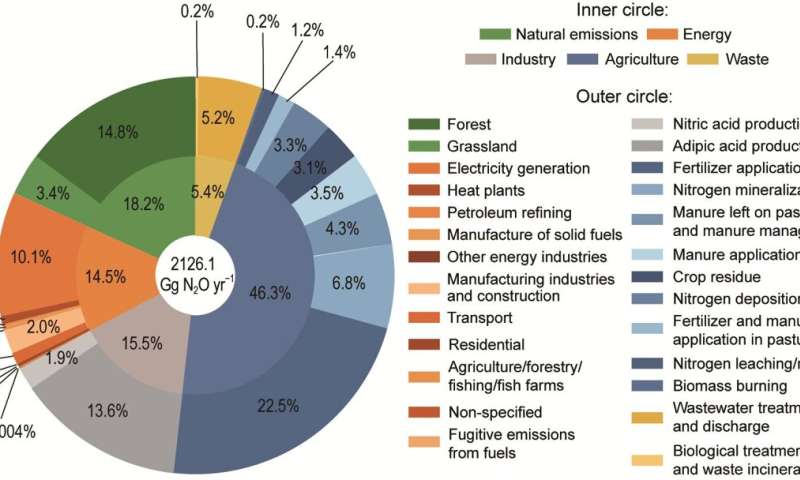Chinese scientists produce a four-decade (1980–2020) inventory of full-scale nitrogen dioxide emissions in China

Nitrous oxide (N2O) is not only one of the most important long-lived greenhouse gases but also the current main stratospheric ozone-depleting substance. China is among the top N2O-emitting countries, so it is important to identify and quantify N2O sources to support making mitigation strategies.
However, existing national inventories focus on either single or short-term N2O sources and fail to provide long-term and full-scale N2O profiles, including both natural and anthropogenic sources.
The total N2O emissions in China were 2126.1 Gg N2O yr−1 for 2010–2020, with 18.2% and 81.8% from natural and anthropogenic sources, respectively.
Agriculture was the largest N2O source, accounting for 46.3 of the total emissions, among which synthetic nitrogen fertilizer applications caused 22.5%. Industry, energy, and waste accounted for 15.5%, 14.5%, and 5.4% of the total emissions, respectively, with adipic acid production, electricity, and wastewater treatment being their individual largest N2O sources.
Chinese N2O emissions increased from 889.6 Gg N2O yr-1 in 1980 to 2295.0 Gg N2O yr-1 in 2020, while agriculture made the largest contribution to this increase. However, this study revealed that agriculture N2O emissions have declined steadily since the release of the Zero Growth in Fertilizer Plan in 2015 by the Chinese government.

In the meantime, industrial and energetic sources exceeded agriculture and became the fastest-accelerating N2O sources in China due to the increasing demand for adipic acid and fossil fuels.
"This FAN 2020 dataset will provide up-to-date information for improving national N2O inventory and further support developing point-targeted mitigation policies. We think it will contribute to the global and national climate actions within the framework of SDG 13," says Dr. Jing Wei from Sun Yat-sen University in Zhuhai, one of the leaders of this study.
Dr. Wenping Yuan and Dr. Jing Wei from Sun Yat-sen University, made the plan to produce a long-term dataset of full-scale N2O emissions in China and designed the experiment. Ms. Minqi Liang, a Ph.D. candidate, Ms. Zheyan Zhou, a Master's candidate, and Ms. Peiyang Ren, a Ph.D. candidate at Sun Yat-sen University, collected the raw data and performed the calculation. All the authors contributed to the writing of the manuscript.
The study is published in the journal National Science Review.
More information:
Minqi Liang et al, Four decades of full-scale nitrous oxide emission inventory in China, National Science Review (2023). DOI: 10.1093/nsr/nwad285
Provided by Science China Press